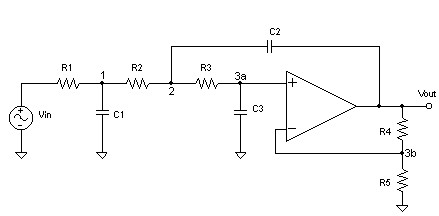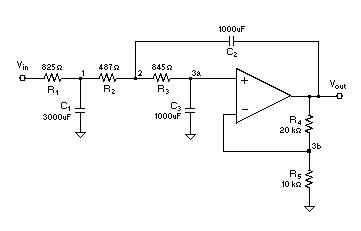
A Sallen-Key 3-Pole Butterworth Active Lowpass Filter - Design Sheet (DS1)
by John-Paul Bedinger
Of the various topologies you can select for making active filters, the Sallen-Key uses the least number of filter components. Furthermore, a 3-pole response (18 db/oct) is possible using only 1 op-amp. Below is a brief mathematical description on how to compute the component values for a Butterworth (steepest response with no ripple) 3-pole lowpass filter with selectable output gain.

Diagram 1: A 3-pole Sallen-Key lowpass filter with output gain.
Circuit Analysis:
Looking at node 3b (where v3 = v3a = v3b) , the node voltage equation can be re-written to be:
![]() (Eq.
1)
(Eq.
1)
Let:
![]() Then:
Then:
![]() (Eq.
2)
(Eq.
2)
The rest of the node voltages can be written:
![]()
![]()
![]()
When solved for the filter transfer function H(s) = Vout/Vin, we get: H(s)=
 (Eq.
3)
(Eq.
3)
Note that the general form of a 3-pole Butterworth lowpass filter at cutoff frequency 1 rad/sec is:
H(s) =
![]() (Eq. 4)
(Eq. 4)
Equating like terms in Equations 3 and 4 gives the solve block:
![]()
![]()
![]()
![]()
where Kac = M.
We choose our output gain: Kac = 3 (9.5 dB)
Also, we choose values for components: C1= 3000 uF, C2= 1000uF, C3= 1000uF, R5= 10 k-ohms
Solving now for R1, R2, R3,and R4 gives:
R1= 816.46 ohms, R2= 481.26 ohms, R3= 848.33 ohms, R4= 10 kohms
Rounding R1-R4 to standard EIA 1% tolerance decade values gives:
R1= 825 ohms, R2= 487 ohms, R3= 845 ohms, R4= 20 k-ohms

Diagram 2: A 3-pole Sallen-Key Butterworth lowpass filter with cutoff at 1 rad/sec and a gain of 3.
Practical Notes:
For different gain values you can refer to my table below, or resolve the solve block with a different value of Kac. Use solutions only with all real positive roots. If you have Mathcad(TM), you can download this zipped Mathcad worksheet to help you.
R1, R2, and R3 from the table can be scaled together by a factor x, which should be done so that R1 is much greater than the source impedance at Vin. This will set the cutoff to 1/x rad/sec.
C1, C2, and C3 from the table can be scaled together by a factor y, which will set the cutoff frequency to 1/(x*y) rad/sec, or:
Fc = 1/(2*3.1416*x*y) Hz
| M(Kac) | 0dB | 6dB | 12dB | 18dB | 24dB | 30dB | 36dB |
| R1(ohms) | 1292 | 15652 | 1624 | 4305 | 3246 | 1437 | 3234 |
| R2(ohms) | 2093 | 14694 | 4067 | 1750 | 2134 | 16260 | 7198 |
| R3(ohms) | 3698 | 4348 | 15144 | 13276 | 1444 | 42794 | 42950 |
| R4(ohms) | 0 | 10000 | 30000 | 70000 | 15000 | 31000 | 63000 |
| R5(ohms) | infinite | 10000 | 10000 | 10000 | 1000 | 1000 | 1000 |
| C1(farads) | 1.E-3 | 100.E-6 | 1.E-3 | 1.E-3 | 1.E-3 | 1.E-3 | 1.E-3 |
| C2(farads) | 1.E-3 | 100.E-6 | 100.E-6 | 100.E-6 | 100.E-6 | 10.E-6 | 10.E-6 |
| C3(farads) | 100.E-6 | 100.E-6 | 100.E-6 | 100.E-6 | 1.E-3 | 100.E-6 | 100.E-6 |
| M(Kac) | 42dB | 48dB | 54dB | 60dB | 66dB | 72dB | 78dB |
| R1(ohms) | 1640 | 1242 | 2243 | 1030 | 1137 | 1700 | 6053 |
| R2(ohms) | 13615 | 69066 | 32123 | 185004 | 285242 | 136533 | 47723 |
| R3(ohms) | 4479 | 116556 | 138815 | 5249 | 308473 | 430832 | 346170 |
| R4(ohms) | 127000 | 25500 | 51100 | 102300 | 20470 | 40950 | 81910 |
| R5(ohms) | 1000 | 100 | 100 | 100 | 10 | 10 | 10 |
| C1(farads) | 1.E-3 | 1.E-3 | 1.E-3 | 1.E-3 | 1.E-3 | 1.E-3 | 1.E-3 |
| C2(farads) | 10.E-6 | 1.E-6 | 1.E-6 | 1.E-6 | 100.E-9 | 100.E-9 | 100.E-9 |
| C3(farads) | 1.E-3 | 100.E-6 | 100.E-6 | 1.E-3 | 100.E-6 | 100.E-6 | 100.E-6 |
Table 1: Prototype component values for a Butterworth filter response at 1 rad/sec.
Example:
We want Fc= 1000 Hz, C1= 0.1uF, C2= 0.1uF, and C3= 0.1uF, and a gain of 6 dB. The source resistance is 10 ohms.
Use Table 1 for 6dB prototype values, then scale y for the correct capacitor range:
The scale factor y is 0.1uF/100uF, or y = 0.001. Thus, 1000 Hz = 1/(2*3.1416*x*0.001). Solving for x gives: x = 0.159
Scaling R1, R2, R3,and R4 by x gives:
R1= 2.489 kohms, R2= 2.336 kohms, R3= 691.3 ohms, R4= 10 kohms, R5=10 kohms
Rounding R1-R4 to standard EIA 5% tolerance decade values gives:
R1= 2.4 kohms, R2= 2.4 kohms, R3= 680 ohms, R4= 10 kohms, R5=10 kohms
Since 2.4 kohms >> 10 ohms source resistance, the value for R1 should work well.
Change Log:
v.1.3.1 Made MathCad file a zip file.
v.1.3 Changed 66db gain resistors in Table 1. (Older values were ok as well)
Moved design sheet to new location on server.
Changed title and included design sheet identifier (DS1)
v1.2 Made R5=10k in solve block constants to match pictured results.
Corrected component values for gains above 36dB in Table 1.
Made bigger JPEG for diagram 1.
Added link to Mathcad(TM) worksheet file.
Made various small text formatting changes, and switched to Arial font.
Added this change log.
Questions or feedback? E-mail me at jpbedinger@hotmail.com
(c)2005 John-Paul Bedinger. All rights reserved. Revision: 1.3.1
Do not duplicate, distribute, or modify without my expressed written permission.
Disclaimer: The author is not responsible for any damages resulting from the content or application of this document. Use at your own risk.